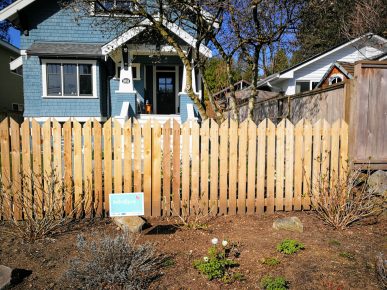Pollinator power
Garden centres are buzzing with homeowners with free time, excellent weather and nowhere to go. Now is the time to think about what kind of garden you'd like and who you want visiting this summer. Creating pollinator habitats is a creative way the community can do something together while we are forced to stay a part.
Butterfly Rangers
 Fromme Road Butterfly Ranger garden.The District of North Vancouver has been a powerful partner for the David Suzuki Foundation’s Butterflyway Project. It has been an ongoing Project in the district since 2018.“Right now we have 15 new Butterfly Rangers,” said Winnie Hwo, David Suzuki Foundation’s senior public engagement specialist and local lead for the program. “The North Shore rangers are the best!”With the addition of 15, there are now 38 throughout the District of North Vancouver, with homes on Wellington and Fromme participating as well as the Lynn Canyon Ecology Centre. The program is active throughout the Lower Mainland focusing on DNV, Richmond and Vancouver. Their mission is to plant native wildflowers in yards, schoolyards, streets and parks to support local bees and butterflies. Their goal was to establish local “Butterflyways” by planting at least a dozen pollinator patches in each neighbourhood. “Environmentally we hear about some big problems, but there is this idea that citizens can make a huge difference if we get ourselves together,” said Hwo. “We think with focused tasks citizens can be part of the solution to support biodiversity.”The Butterflyway Project focuses on wild bees and butterflies. Official rangers are supported with training, virtual meetings and a few plants. “Pollinators help make our food and we know they are in trouble. We have used too much land, we use too many pesticides. Their lives are getting more difficult,” said Hwo. “Butterflies are the great ambassadors. If people plant for butterflies it benefits bees. A lot of the flowers that butterflies fly on are the same flowers bees fly on.”
Fromme Road Butterfly Ranger garden.The District of North Vancouver has been a powerful partner for the David Suzuki Foundation’s Butterflyway Project. It has been an ongoing Project in the district since 2018.“Right now we have 15 new Butterfly Rangers,” said Winnie Hwo, David Suzuki Foundation’s senior public engagement specialist and local lead for the program. “The North Shore rangers are the best!”With the addition of 15, there are now 38 throughout the District of North Vancouver, with homes on Wellington and Fromme participating as well as the Lynn Canyon Ecology Centre. The program is active throughout the Lower Mainland focusing on DNV, Richmond and Vancouver. Their mission is to plant native wildflowers in yards, schoolyards, streets and parks to support local bees and butterflies. Their goal was to establish local “Butterflyways” by planting at least a dozen pollinator patches in each neighbourhood. “Environmentally we hear about some big problems, but there is this idea that citizens can make a huge difference if we get ourselves together,” said Hwo. “We think with focused tasks citizens can be part of the solution to support biodiversity.”The Butterflyway Project focuses on wild bees and butterflies. Official rangers are supported with training, virtual meetings and a few plants. “Pollinators help make our food and we know they are in trouble. We have used too much land, we use too many pesticides. Their lives are getting more difficult,” said Hwo. “Butterflies are the great ambassadors. If people plant for butterflies it benefits bees. A lot of the flowers that butterflies fly on are the same flowers bees fly on.”Making your garden butterfly and bee friendly.
With applications closed for official rangers for the year (mark your calendars for January next year to apply), there are lots ways you can get involved to make your garden more pollinator friendly. It begins in the fall. “A messy yard - an organized mess - benefits pollinators,” said Hwo. “Pollinators lay eggs on leaves - especially if you are planting the pollinator plants. We don’t want to disrupt their life cycle and ecosystem. When leaves drop there are little lives growing on them.”Leaving leaves on the ground until spring and gently gathering into piles can be an ideal way to support pollinators. “Leaf blowers are like a tsunami - nothing is left. Raking into piles will have little disruption and leaving it for organisms to grow will be hugely beneficial for butterflies and their lifecycle.”For our climate the Butterflyways Project recommends 12 plants, in this handy PDF from the David Suzuki Foundation:Common Camas - Camassia quamash
 Virginia strawberry
Virginia strawberryGoldenrod - Solidago multiradiata
Pearly Everlasting - Anaphalis margaritacea
Pacific Bleeding Heart - Dicentra formosa
Nodding Onion - Allium cernuum
Coastal Kinnikinnick - Arctostaphylos uva-ursi
Virginia Strawberry - Fragaria virginiana
Western Yarrow - Achillea millefolium
Douglas Aster - Aster subspicatus
Salal - Gaultheria shallon
Hardhack - Spiraea douglasii
Ocean Spray - Holodiscus discolor
Host plants: Adults need a place to lay eggs where their caterpillars will forage. (Plant species that will get eaten and not just look pretty!)
Mud puddles: Some butterflies rarely visit flowers. They prefer mud, poop (a.k.a. “scat” or “dung”), sap and rotting fruit.
Blooms from spring through fall: Don’t limit your garden to an end-of-July colour extravaganza. You’ll need a diversity of native nectar plants to flower over a few months.
Overwintering habitat: Consider not raking leaves to provide a butterfly nursery! Most butterflies in Canada overwinter as caterpillars, others as pupae. A few species winter as adults, hibernating in hollow trees, under bark and firewood piles, or in garden shed cracks and crevices. ew spend winter as eggs.
Sunshine: Make sure you (or your neighbours) have sunny spots.
Nectar plants: Most butterflies will feed from more than a few plant species
Learning more
The DNV is home to a special part of the Butterfly Project. Off of Dollarton there is a particular neighbourhood embracing the concept, culminating in the Butterfly Lane, led by Stephen Deedes-Vincke and Sally Hocking. Check it out on Google Maps or visit.Join iNaturalist’s Butterflies in My Backyard observation collaboration - another project supported by Deedes-Vinvke. Download the app and help track Lynn Valley and North Vancouver’s biodiversity. The Lynn Canyon Ecology Centre is hosting online gardening workshops through April and May. Nothing specific to pollinators, but lots of great gardening topics.Looking for more?
There's always something fun and exciting happening in Lynn Valley. Check out our Community Events Calendar or learn more about Local Activities, Mountain Biking or Hiking and Walking Trails.Looking for more?
-
Dec 161:00 PM - 2:30 PMLynn Valley Library 1277 Lynn Valley Rd, North Vancouver BC V7J 0A2, Canada
-
Dec 17
Lynn Valley Legion General Meeting
6:30 PM - 7:30 PMRoyal Canadian Legion, 1630 Lynn Valley Rd, North Vancouver, BC V7J 2B4, Canada -
Dec 18
Hot Cocoa with a Youth Worker
3:30 PM - 4:15 PMLynn Valley Library 1277 Lynn Valley Rd, North Vancouver BC V7J 0A2, Canada -
Dec 19
Meat Draw and 50/50
6:30 PM - 8:30 PMRoyal Canadian Legion Branch 114, 1630 Lynn Valley Rd, North Vancouver, BC V7J 2B4, Canada






